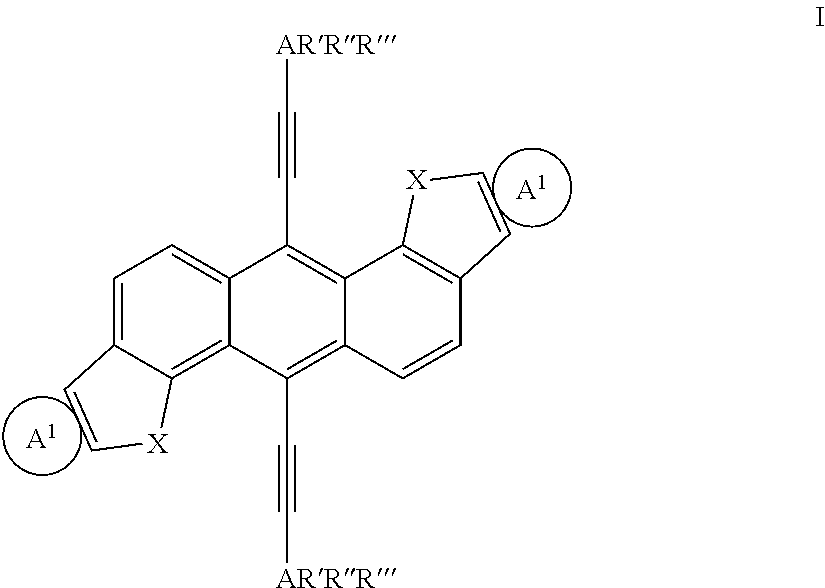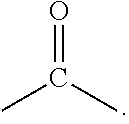Extended non-linear acene derivatives and their use as organic semiconductors
a non-linear acene and derivative technology, applied in the field of extended non-linear acene derivatives, can solve the problems of reducing device performance, unsuitable for large-area film fabrication, and expensive vacuum deposition processing technology
- Summary
- Abstract
- Description
- Claims
- Application Information
AI Technical Summary
Benefits of technology
Problems solved by technology
Method used
Image
Examples
example 1
B
Dibenzothiophene-4-carboxylic acid diethylamide
[0240]
[0241]To a mixture of dibenzothiophene-4-carboxylic acid (10.0 g, 44 mmol) and anhydrous dichloromethane (150 cm3) is added thionyl chloride (6.4 cm3, 88 mmol) and dropwise anhydrous N,N-dimethylformamide (3.4 cm3, 44 mmol). After addition, the mixture is heated at reflux for 17 hours. The mixture cooled and the volatiles removed in vacuo. The residue taken up in anhydrous ether (150 cm3) and diethylamine (14 cm3, 130 mmol) added. The mixture is then stirred at 23° C. for 17 hours. Water (100 cm3) is added and the organics are extracted with dichloromethane (2×100 cm3). The combined organics are dried over anhydrous magnesium sulfate, filtered and the solvent removed in vacuo. The crude is passed through a plug of silica (1:1; dichloromethane:ether) to give dibenzothiophene-4-carboxylic acid diethylamide (9.6 g, 77%) as an off-white crystalline solid. 1H-NMR (300 MHz, CDCl3) 0.94-1.51 (6H, br m), 3.13-3.82 (4H, br m), 7.41-7.53 (...
example 2
C
[0246]
[0247]To a solution of (triethylsilyl)acetylene (0.30 g, 2.1 mmol) in anhydrous tetrahydrofuran (10 cm3) at 0° C. is added dropwise n-butyllithium (0.8 cm3, 2 mmol, 2.5 M). After addition, the mixture is stirred at 0° C. for 5 minutes and then at 23° C. for 30 minutes. Compound A (0.09 g, 0.2 mmol) is then added as a solid and the reaction mixture stirred at 23° C. for 3 hours. A saturated solution of tin (II) chloride in 10% aqueous hydrochloric acid (8 cm3) is added and the reaction mixture stirred at 30° C. for 30 minutes. The mixture cooled, poured into methanol (100 cm3) and the solid collected by filtration. The solid is taken up in dichloromethane (100 cm3), washed with water (100 cm3) and the organic dried over anhydrous magnesium sulphate, filtered and the solvent removed in vacuo. The crude is purified by column chromatography (gradient from 40-60 petrol to dichloromethane) followed by recrystallisation (tetrahydrofuran / methanol) to give compound C (29 mg, 20%) as a...
example 3
D
[0248]
[0249]To a solution of (triisopropylsilyl)acetylene (2.1 cm3, 9.5 mmol) in anhydrous tetrahydrofuran (40 cm3) at 0° C. is added dropwise n-butyllithium (3.4 cm3, 8.6 mmol, 2.5 M). After addition, the mixture is stirred at 0° C. for 5 minutes and then at 23° C. for 30 minutes. Compound A (0.40 g, 0.95 mmol) is then added as a solid and the reaction mixture stirred at 23° C. for 41 hours. A saturated solution of tin (II) chloride in 10% aqueous hydrochloric acid (20 cm3) is added and the reaction mixture stirred at 30° C. for 30 minutes. The mixture cooled and poured into water (100 cm3), the solid collected by filtration and washed with methanol (100 cm3). The crude is purified by recrystallisation (tetrahydrofuran / methanol) followed by heated column chromatography (40-60 petrol:dichloromethane; 3:2) followed by recrystallisation (tetrahydrofuran) to give compound D (100 mg, 14%) as an orange solid. 1H-NMR (300 MHz, CDCl3) 0.35-1.53 (42H, m), 7.51-7.60 (4H, m), 7.96-8.02 (2H, ...
PUM
| Property | Measurement | Unit |
|---|---|---|
| temperature | aaaaa | aaaaa |
| permittivity | aaaaa | aaaaa |
| semiconducting | aaaaa | aaaaa |
Abstract
Description
Claims
Application Information
 Login to View More
Login to View More - R&D
- Intellectual Property
- Life Sciences
- Materials
- Tech Scout
- Unparalleled Data Quality
- Higher Quality Content
- 60% Fewer Hallucinations
Browse by: Latest US Patents, China's latest patents, Technical Efficacy Thesaurus, Application Domain, Technology Topic, Popular Technical Reports.
© 2025 PatSnap. All rights reserved.Legal|Privacy policy|Modern Slavery Act Transparency Statement|Sitemap|About US| Contact US: help@patsnap.com



